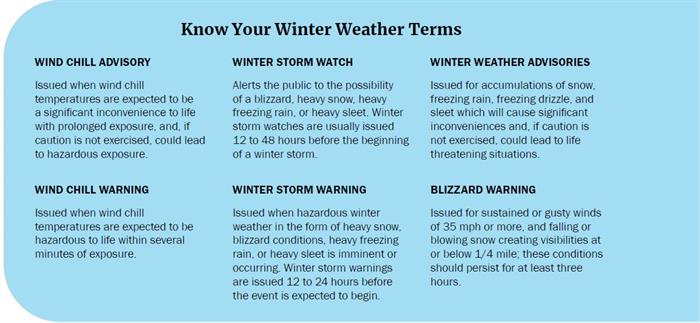
Employers need to know the wind chill temperature so that they can gauge workers’ exposure risk better and plan how to work safely. It is also important to monitor workers’ physical condition during tasks, especially new workers who may not be used to working in the cold, or workers returning after spending some time away from work.
Who is affected by environmental cold?
Environmental cold can affect any worker exposed to cold air temperatures and puts workers at risk of cold stress. As wind speed increases, it causes the cold air temperature to feel even colder, increasing the risk of cold stress to exposed workers, especially those working outdoors, such as recreational workers, snow cleanup crews, construction workers, police officers and firefighters. Other workers who may be affected by exposure to environmental cold conditions include those in transit, baggage handlers, water transportation, landscaping services and support activities for oil and gas operations.
Risk factors for cold stress include:
- Wetness/dampness, dressing improperly and exhaustion
- Predisposing health conditions such as hypertension, hypothyroidism and diabetes
- Poor physical conditioning
What is cold stress?
What constitutes cold stress and its effects can vary across different areas of the country. In regions that are not used to winter weather, near freezing temperatures are considered factors for "cold stress." Increased wind speed also causes heat to leave the body more rapidly (wind chill effect). Wetness or dampness, even from body sweat, also facilitates heat loss from the body. Cold stress occurs by driving down the skin temperature, and eventually the internal body temperature. When the body is unable to warm itself, serious cold-related illnesses and injuries may occur, and permanent tissue damage and death may result. Types of cold stress include: trench foot, frostbite and hypothermia.
How can cold stress be prevented?
Although OSHA does not have a specific standard that covers working in cold environments, under the Occupational Safety and Health Act (OSH Act) of 1970, employers have a duty to protect workers from recognized hazards, including cold stress hazards, that are causing or likely to cause death or serious physical harm in the workplace.
Employers should train workers. Training should include:
- How to recognize the environmental and workplace conditions that can lead to cold stress
- The symptoms of cold stress, how to prevent cold stress and what to do to help those who are affected
- How to select proper clothing for cold, wet and windy conditions
Employers should:
- Monitor workers physical condition
- Schedule frequent short breaks in warm dry areas, to allow the body to warm up
- Schedule work during the warmest part of the day
- Use the buddy system (work in pairs)
- Provide warm, sweet beverages; avoid drinks with alcohol
- Provide engineering controls such as radiant heaters
Types of Cold Stress
Immersion/Trench Foot
Trench foot is a non-freezing injury of the feet caused by prolonged exposure to wet and cold conditions. It can occur in temperatures as high as 60°F if feet are constantly wet. Injury occurs because wet feet lose heat 25-times faster than dry feet. [CDC/NIOSH]
What are they symptoms of trench foot?
Reddening skin, tingling, pain, swelling, leg cramps, numbness and blisters.
Frostbite
Frostbite is caused by the freezing of the skin and tissues. Frostbite can cause permanent damage to the body, and in severe cases can lead to amputation. The risk of frostbite is increased in people with reduced blood circulation and among people who are not dressed properly for extremely cold temperatures.
What are the symptoms of frostbite?
Reddened skin develops gray/white patches in the fingers, toes, nose, or ear lobes; tingling, aching, a loss of feeling, firm/hard, and blisters may occur in the affected areas.
Hypothermia
Hypothermia occurs when the normal body temperature (98.6°F) drops to less than 95°F. Exposure to cold temperatures causes the body to lose heat faster than it can be produced. Prolonged exposure to cold will eventually use up the body’s stored energy. The result is hypothermia, or abnormally low body temperature. Hypothermia is most likely at very cold temperatures, but it can occur even at cool temperatures (above 40°F) if a person becomes chilled from rain, sweat or immersion in cold water.
What are the symptoms of hypothermia?
An important mild symptom of hypothermia is uncontrollable shivering, which should not be ignored. Although shivering indicates that the body is losing heat, it also helps the body to rewarm itself. Moderate to severe symptoms of hypothermia are loss of coordination, confusion, slurred speech, heart rate/breathing slow, unconsciousness and possibly death. Body temperature that is too low affects the brain, making the victim unable to think clearly or move well. This makes hypothermia particularly dangerous because a person may not know what is happening and won’t be able to do anything about it.
Source: National Oceanic and Atmospheric Administration (NOAA)